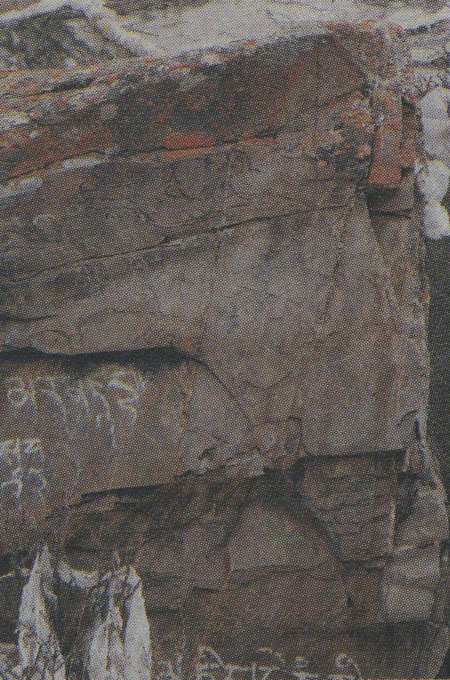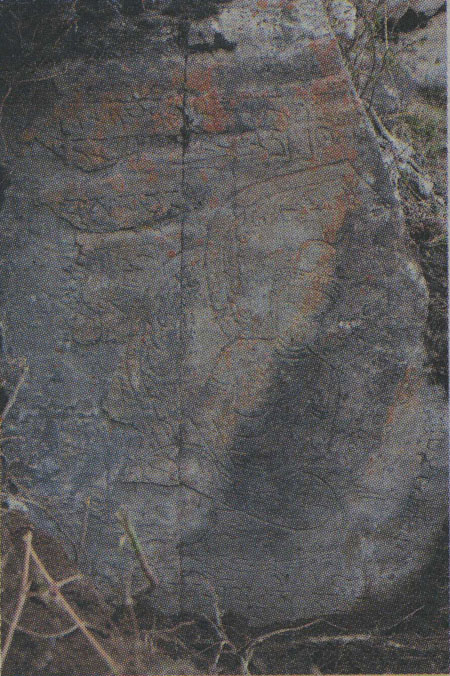A Large-scale Tubo period cliff inscriptions discovered in Sichuan, Southwest China
From:Chinese Archaeology NetWriter:Date:2014-04-11
From 2010 to 2013 the Sichuan Provincial Institute of Cultural Relics and Archaeology and the Cultural Bureau of Shiqu County in Ganzi Prefecture have conducted a joint investigation to the early cliff carvings in Shiqu County, Sichuan province. Successively three stone inscriptions remains including 18 units have been found respectively on the Xuba Holy Mountain, on the Baima Holy Mountain and in the Yanjiaochun village, which are indeed important achievements. The carvings are in good state of conservation, covering a rich variety of motifs including images of the Five Buddhas, Vairocana, Bodhisattvas, Tara and ancient Tibetan inscriptions, which are basically prevalent motifs of the Tubo period. The basic characteristics of the images comply with the typical style of that time.


cliff carvings and it's rubbings at Xuba Mountain
The Xuba Holy Mountain cliff carvings
Among the newly found three remains, the Xuba carvings are the most important due to its largest number and concentration. Besides various Buddhist images, there are numerous ancient Tibetan inscriptions. The extant 14 images are mostly represented with incised lines, and only 2 are in low relief. The No.1 image shows the upper body of a figure standing on his side, wearing a high cylindrical cap, with two braids hanging to the chest. At the earlobes there are ribbon knots to tie the hair. In addition to the long robe, the costume is of a typical Tubo noble. The figure has a round halo with fire fringe, and holds a long-stemmed locus in one hand. It could be identified as Bodhisattvas, the first Bodhisattvas figure with Tubo costume found in Shiqu, which is important evidence of Buddhism’s localization in Tubo Empire. The No.7 image represents a Buddha in the upper middle, below which there are 8 rows of Tibetan inscriptions. The text is eulogy for Buddha, quite rare and complete in Tubo period. The No.5 carvings have 4 rows of inscriptions praying for the Tibetan king to be healthy and live longer, the empire to be powerful and human to be happy. The No.11 carving is the image of a flying deva engraved with lines. She wears a tall cylindrical cap, wearing scarfs and a skirt. She holds a stemmed locus in one hand, flanked by two large wings at the waist. The whole body presents a zigzag-shaped pose, and the lower part of the body is hidden behind the wings. The flying deva with Tubo costume is quite rare and unique which are very important materials. The No.13 carving has 12 rows of Tibetan inscriptions which providing important clues to date back the Xuba carvings to the King Khri-sRong IDe-bTsan period, i.e. the end of 8th century to the beginning of 9th century. These findings are of great importance for studying stone carvings and sculptures from the Tubo period, and are helpful to establish an iconographic standard of that time. They also provide valuable materials for researching Buddhist figures and ancient Tibetan writing.


cliff carvings at Xuba Mountain
The Baima Holy Mountain carvings
The Baima Holy Mountain carvings include two locations, the Gengsha village at the eastern foot of the Mountain and the Luoxu village at the western foot. The carvings in the former location represent a figure of the Happy Buddha with incised lines accompanied with low relief. Only the face and the locus pedestal are preserved well, and the rest parts are badly damaged, while the tall cylindrical cap and triangular shaped collar are recognizable. Due to the bad condition of the figure and the absence of text, as well as that the Happy Buddha generally emerged in the early period of the Later Spread of Buddhism, the Gengsha site is very possibly the remains of that time.
The Luoxu village has two carvings engraved on independent rocks with 200 m distance apart. The two carvings are both represented with incised lines and are serious damaged. No text has been found. The inscription at the right side of the No.2 image seems to be a later addition. The figures with three-faced crowns, unique costume and locus pedestals are of typical Tubo style.


cliff carvings and it's rubbings at Xuba Mountain

cliff carvings Xuba Mountain
The Yanjiao village carvings
The carvings are engraved on a huge rock on the north bank of the Jinsha River. A single seated Buddha is represented with incised lines. He wears a three-faced crown, ear pendants, necklace and armlets, sitting on a locus stool with legs crossed. The upper body is naked hanging with jewelry. The figure could be Vairocana with bodhisattva’s dressing. The carvings are in good state of preservation. No early inscriptions have been found except some later additions. Vairocana is the main deity in esoteric Buddhism, whose images are very popular in eastern Tibet and Yushu region in Qinghai. The motif is prevalent in Tubo period.
The newly found carvings in Shiqu feature large number, rich variety of motifs, high value and well preservation. It is the first region in Sichuan where large area of Tubo carvings has been found, which provides new materials for studying the ancient Tubo routes in Tang dynasty and makes up the missing links. It is of great significance for studying Buddhism history of Tubo Empire, the art history and the relationship between Tang dynasty and Tubo empires, as well as the Buddhism’s regional development on the Tibetan Plateau. (Translator: Tong Tao)

